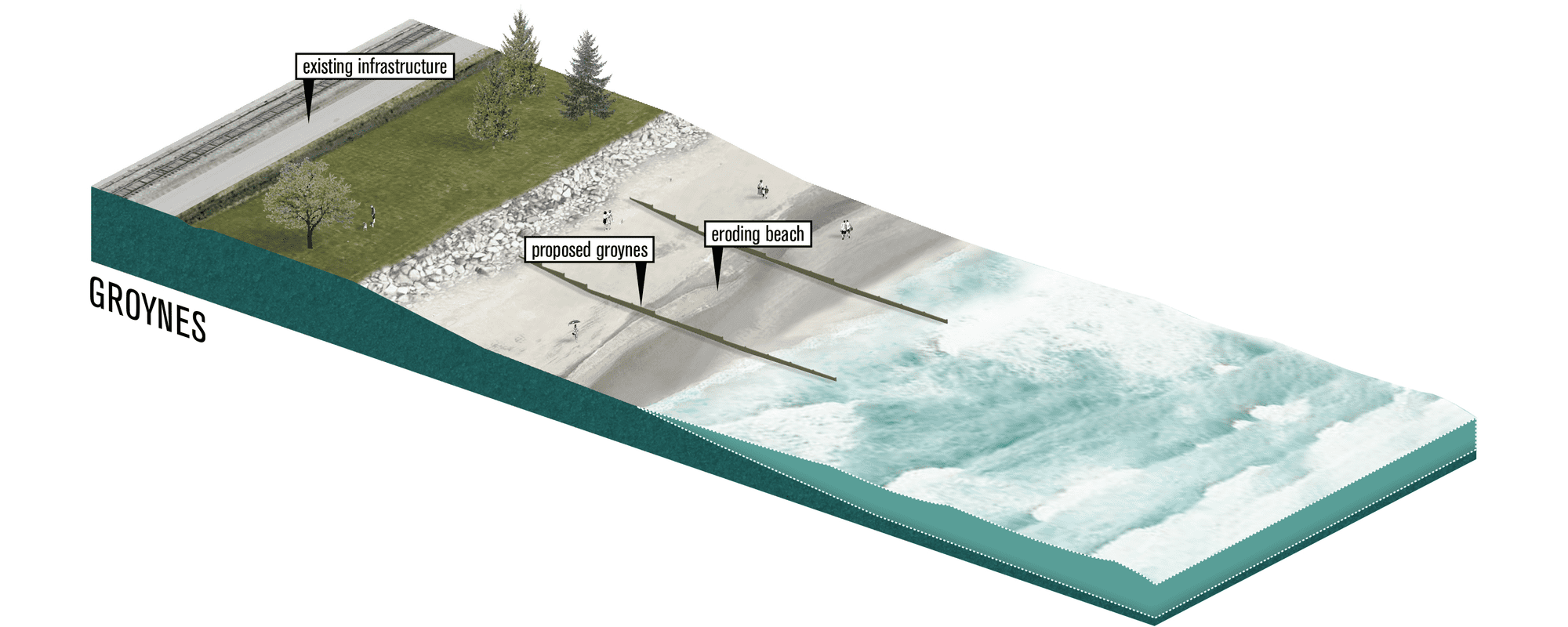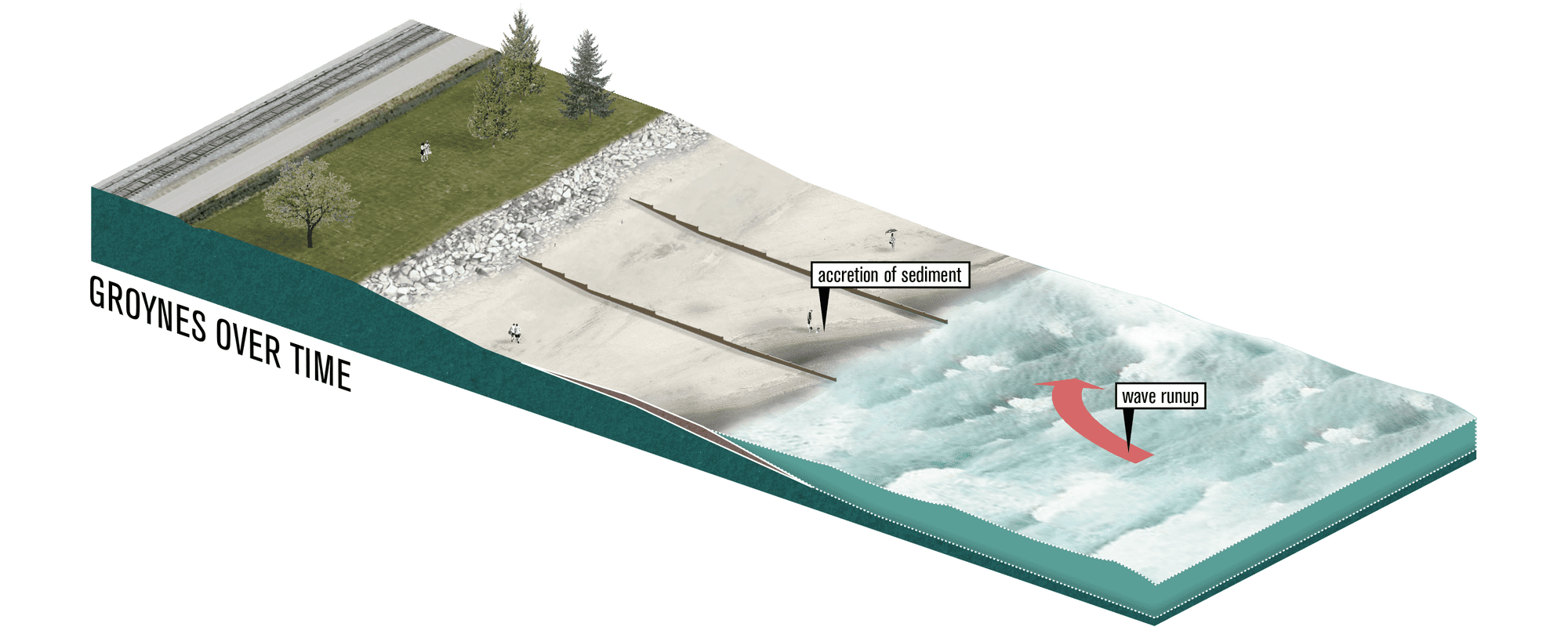Adaptation Strategy: Groynes
Groynes are rigid structures, typically constructed using heavy materials extending from the upper shore to the water.1 They are used in combination with beach nourishment by trapping beach material that is transported during high wave conditions.2 Groynes can be constructed using various materials including timber, steel, concrete to rubble-mounds. Each material has different strengths and weaknesses and life expectancies. Long-term maintenance is required, and the replacement of groynes are common in flood management plans. As a response to downdrift erosion construction of groynes should be accompanied by a regular recycling or nourishment program.3
How it works
Types of groynes
- Wooden groynes usually consist of one or two-row palisade structures that are usually permeable. Wood groynes are cheap but have low durability.
- Rock groynes are simple to construct and have long durability. They can also be dismantled and reinstalled
- Concrete groynes are usually constructed from prefabricated boxes or reinforced concrete hence they are very durable and long-lasting. However, they require a foundation with a high load-bearing capacity
- Rubble-mound groynes can be built using loose mounds of stones or other materials, e.g., tetrapods 13
Benefits
- Creates an opportunity for beach widening which is valuable to recreational tourism.
- Traps sediments and widens beach thereby reducing erosion and increasing wave energy dissipation.
- Acts as a sturdy structure which can be used for long term stabilization of coastline
- Can be used in tandem with other approaches, e.g., beach nourishment and hard engineering measures
- Enjoys widespread global acceptance based on experience with design and construction.
Challenges
- Provides limited protection against extreme storm events
- Reduces transport of sediments down the coastline
- Causes downdrift erosion
- Complementary to artificial nourishment, e.g., could reduce positive impacts on coastlines down-drift
- Rip currents may occur adjacent to groynes presenting hazards to bathers and other users
- May lead to sediment loss during storm events
- May negatively impact coastline appearance, given its unnatural, shore perpendicular structure 14
Example projects
Beach Groynes
Surrey BC, Canada
Coastal erosion has been a problem at Crescent Beach since 1914, in response, a timber groyne system was implemented along the West Beach.8 The groyne system helps to protect the beach from further erosion and the existing dike.9 In 1999, an assessment was done to identify the causes of shoreline erosion that was observed years after the construction of the groynes.10 The study showed that the cause of shoreline erosion was due to the decrease in sediment supply, sediment transport, damaged groynes, and frequent storm events.11 Since 2001, remediation of the beach was undertaken including the repair and replacement of the groynes and a recommendation for beach nourishment.12
Aberdeen Beach Groynes
Aberdeen SCT, UK
Historically, Aberdeen Beach has had significant problems with coastal erosion and has experienced a substantial loss of beach sediment. This is based on the inspections that were done in 2001 and 2004.4 Beach elevation in front of the seawall has decreased to the point where sheet piling was exposed, causing the seawall to be exposed to failure.5 In response, in 2006, the Aberdeen City Council decided to implement a major beach nourishment and groyne construction program.6 Across a 600m stretch of the Aberdeen Beach, 750 m of dredging pipeline was used to pump 70 000 m3 of dredged sand along the beach and 1800 tons of granite blocks were used in the construction of 5 groynes.7 This represented a reactive response to the coastal erosion along the seawall. However, with climate change and sea-level rise, there are still concerns about the long-term durability and consequences of the groynes.
Citations
-
1.
↑
The Arlington Group Planning Architecture Inc., et al. Sea Level Rise Adaptation Primer. pp. 68. https://www2.gov.bc.ca/assets/gov/environment/climate-change/adaptation/resources/slr-primer.pdf
-
2.
↑
“Groynes.” Groynes | Coastal Management Webguide - RISC KIT, https://www.coastal-management.eu/measure/groynes-0.
-
3.
↑
Ibid.
-
4.
↑
Aberdeen Beach Case Study. University of Aberdeen, pp.8. https://www.abdn.ac.uk/geosciences/documents/Aberdeen_Beach_-_Case_Study.pdf.
-
5.
↑
Ibid, 8.
-
6.
↑
Ibid, 8.
-
7.
↑
Ibid, 8.
-
8.
↑
Crescent Beach Erosion Protection. pp. 2. https://www.surrey.ca/bylawsandcouncillibrary/CR_1999-C413-5243.pdf.
-
9.
↑
Ibid, 2.
-
10.
↑
Cresecent Beach Climate Change Adaptation Strategy. City of Surrey, June 2009, pp. 8. https://www.surrey.ca/files/CrescentBeachClimateChangeAdaptationStudyReport2009.pdf.
-
11.
↑
Ibid, 8.
-
12.
↑
Ibid, 8.
-
13.
↑
CHAPTER - 4 GROYNES TYPE BUNDS: FUNCTION AND EFFECTS ON SHORELINE https://shodhganga.inflibnet.ac.in/bitstream/10603/174903/16/13_chapter%204.pdf
-
14.
↑
Climate Technology Center and Network. (nd). Climate Change Adaptation Technologies for Water A practitioner’s guide to adaptation technologies for increased water sector resilience WATER ADAPTATION TECHNOLOGY BRIEF. Groynes. https://www.ctc-n.org/sites/www.ctc-n.org/files/resources/groynes.pdf
-
i1.
↑
Aberdeen Beach Groynes. https://www.pressandjournal.co.uk/wp-content/uploads/sites/2/2015/03/Aberdeen-beach-weather.jpg.
-
i2.
↑
C., Arnold. A Groyne at Crescent Beach. https://upload.wikimedia.org/wikipedia/commons/thumb/e/e1/Cresbeach-groyne.jpg/1280px-Cresbeach-groyne.jpg.
-
i3.
↑
Figure 1. The constructor. (2020). Gyrones and their classification. https://theconstructor.org/water-resources/hydraulic-structures/groynes-classification/30554/
-
i4.
↑
Figure 2. https://www.dreamstime.com/photos-images/aberdeen-scotland-beach.html

